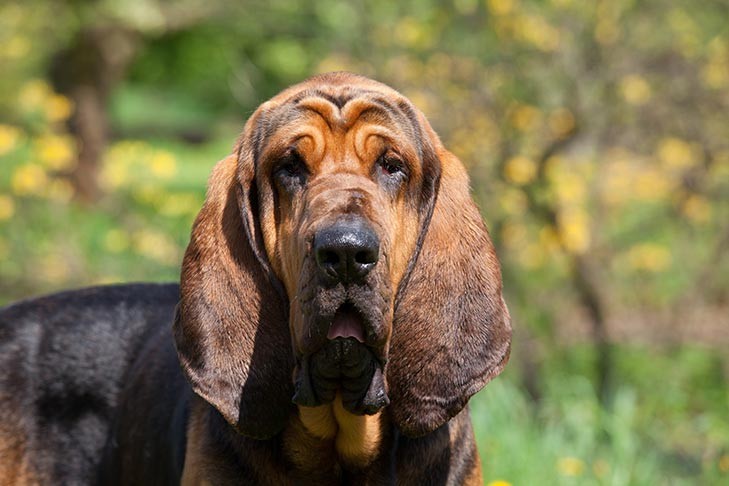Drooling, slobbering, or whatever you call it, is a common occurrence for many dog owners. While some level of drool is perfectly normal, especially for certain breeds, excessive drooling can sometimes be a sign of an underlying issue. So, Why Is My Dog Drooling more than usual? Just like barking and tail-wagging are part of being a dog, so is drooling. However, understanding the difference between normal and abnormal drooling is crucial for your dog’s health and your peace of mind.
Normal Dog Drooling: When Slobber is Just Slobber
In the veterinary world, excessive drooling is known as ptyalism. For some breeds, like Bloodhounds, Saint Bernards, and Mastiffs, drooling is simply a part of their charm. These breeds are predisposed to drooling due to their facial anatomy. They have loose skin around their lips and muzzle, creating folds that act like reservoirs for saliva. This saliva then drips from their flews (those big, floppy upper lips) or gets flung around when they shake their heads. Drinking water can also become a messy affair, with water getting trapped in all that loose skin and eventually escaping.
For owners of these breeds, a “drool rag” becomes an essential accessory. Keeping a towel handy to wipe your dog’s muzzle regularly can save your floors and furniture from unwanted slobber. It’s especially important to wipe their face after meals and drinks. Some owners even find bandanas helpful in catching some of the drool.
Even breeds not typically known for drooling will drool occasionally. Anticipation of food is a major trigger. Saliva plays a vital role in digestion, starting the process in the mouth. The mere thought or smell of delicious food, like a juicy steak, can get your dog’s mouth watering. Similarly, a bad taste, such as certain medications, can also stimulate saliva production as the body tries to wash out the unpleasant flavor. These instances of drooling are perfectly normal. But when does drooling become a cause for concern? There are several medical conditions that can lead to either an overproduction of saliva or an inability to swallow saliva normally, both resulting in excessive drooling.
Potential Health Issues Behind Excessive Drooling
If you’re noticing a sudden increase in your dog’s drooling, or if it seems excessive even for their breed, it’s important to consider potential underlying health issues. These can range from minor irritations to more serious medical conditions.
Mouth and Throat Problems
Anything that hinders your dog’s ability to swallow properly can lead to saliva building up and dripping out of their mouth. Dental problems are a common culprit. A fractured tooth, oral tumors, or even just significant tartar buildup and gum irritation (gingivitis) can all cause increased drooling. Mouth infections can also stimulate excessive saliva production.
Another frequent cause is a foreign body lodged in the mouth or throat. Anything stuck between teeth or caught in the throat, like a small bone fragment, can cause significant drooling and discomfort.
Regular dental care is crucial for preventing many of these issues. Daily tooth brushing and regular veterinary dental checkups are essential. Be vigilant about checking your dog’s mouth for signs of dental disease such as yellow or brown plaque, inflamed gums, unusual lumps, or foreign objects. Any of these signs warrant a prompt visit to your veterinarian.
Stomach Upset and Nausea
Issues in the digestive system can also manifest as excessive drooling. Motion sickness is a common cause of nausea in dogs, and drooling is a classic symptom of nausea. If your dog drools in the car, it’s likely due to motion sickness, and the drooling should subside once the car ride is over. For dogs prone to car sickness, desensitization training and veterinary-prescribed anti-nausea medications can be helpful.
Ingestion of inappropriate items or toxins can also lead to stomach upset and drooling. If your dog eats something indigestible, like a sock or toy stuffing, it can cause gastrointestinal distress. Similarly, toxic substances, such as poisonous plants or household cleaners, can trigger drooling along with other symptoms like vomiting, shaking, or lethargy. Always be aware of potential toxins in your home and garden. If you suspect your dog has ingested something poisonous, contact your veterinarian or an animal poison control center immediately.
Other Medical Conditions
Beyond dental and gastrointestinal issues, a range of other health conditions can include drooling as a symptom. Heatstroke, for instance, can cause excessive panting and drooling as a dog tries to cool down. After a seizure, dogs may also drool. Infections of the nose, throat, or sinuses, as well as neuromuscular conditions like paralysis or tetanus, can also lead to drooling. More serious systemic diseases like kidney disease, liver disease, and even rabies can also present with drooling as a symptom.
While drooling alone might not always indicate a serious problem, it’s crucial to be aware of any accompanying symptoms. Pay attention to changes in appetite or behavior, neurological signs like seizures or difficulty standing, retching or vomiting saliva, and any changes in the saliva itself, such as foul odor, thickness, or the presence of blood.
In some cases, like bloat (gastric dilatation-volvulus), excessive drooling can be a sign of a life-threatening emergency requiring immediate veterinary intervention.
When to See a Veterinarian
Any significant change in your dog’s drooling habits should be taken seriously. While some drooling is normal, especially in certain breeds or in anticipation of food, excessive, sudden, or changed drooling can be a sign of an underlying medical issue. If you are concerned about why your dog is drooling, and especially if it’s accompanied by other symptoms like those mentioned above, it’s always best to err on the side of caution and consult with your veterinarian. Prompt diagnosis and treatment can make a significant difference in your dog’s health and well-being.
